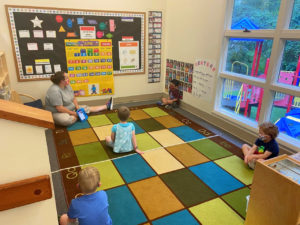
A Note From Our Principal
Spring has finally arrived and we want to make sure all of our students can take full advantage of our outdoor play spaces. Please make sure that your child has a spare set of well-fitting, weather-appropriate clothes that are labeled. Additionally, now is a great time to start collecting sunscreen so that we are ready for the first hot and sunny day of the year. Please label all containers of sunscreen that you send to school with your child. Our teachers are planning outdoor games, lessons and picnics to celebrate spring. We can’t wait to share these activities with your child!
Sincerely,
Tara Clerc

Earth Day 2021
Our classes will be celebrating Earth Day on April 22 by releasing ladybugs and planting flowers. We can’t wait to share photos on Links 2 Home!

Important Dates
April 2nd — School Closed
April 12th-16th – Week of the Young Child
April 22nd — Earth Day
April 27th— Playground Picnic (details later)
April 28th— Memorable Moment Photos (Toddlers & Beginners)
April 29th— Memorable Moment Photos (Intermediates & PreK)
April 30th— Memorable Moment Photos (Make-Up)
April 30th—Links to Learning Parent folders go home
New On Our Preschool Blog

The Importance of Routines for Preschoolers
As we continue to navigate the ever-changing COVID-19 pandemic, maintaining a consistent routine for our students in a safe and fun environment is our top priority. Below are a few reasons why routines are important for young children and how we help achieve this in the classroom.
Children learn to manage themselves when they understand expectations in their environment and what comes next.
An organized, clean and welcoming classroom is not only the foundation for quality teaching, but it also helps shape and define positive student behavior. Our classrooms have developmentally appropriate interest areas called centers that reinforce writing and other curriculum skills. In centers, teachers encourage student choice and exploration with the guidance of a visual center management system, which helps children know when they can move to a new center. This practice helps them learn routines, self-monitoring and decision-making. Other visual cues in our classrooms include footprint outlines to remind students where to line up, picture instructions of how to wash hands, and picture/word labels to help children know where each toy goes.
Children handle change best if it’s expected and occurs in the context of a familiar routine.
During times of potential chaos, a structured routine provides comfort, stability and a sense of safety. Transitions from one activity to another can be frustrating and stressful for children, because they take time and can involve waiting. To help ease transitions and help set expectations, our teachers provide verbal and non-verbal cues, such as songs or sounds. They may also wear a silly hat to attract attention or provide children with small toys, such as bubbles or action cards, to make the transition fun and engaging.
Routines help children demonstrate independence, while fostering feelings of belonging and self-confidence.
Circle time is a part of our students’ everyday routine that helps establish roles, reinforces learning, encourages student interaction, creates unity and builds relationships. During circle time, students select helper jobs such as flag holder, book holder or weather observer. These jobs help them actively engage in the activity and see themselves as important members of the classroom community. Teachers make children feel valued by acknowledging how the helpers are important to the circle time routine.
A grandparent of one of our students recently told us, “My granddaughter is only a toddler but it’s clear that she understands her school routine. When she visits me, she stops at the coat closet until I hang up her coat. At lunch, she hands me her bib and says “up” to get seated in her highchair. After eating, she carries her dishes over to the sink and helps wipe off her tray. Thank you for instilling these routines with her. It makes our time together run smoothly!” What a great example of our classroom routines in real life!
This entry was posted in Columbia. Bookmark the
permalink. Both comments and trackbacks are currently closed.

April Newsletter
A Note From Our Principal
Spring has finally arrived and we want to make sure all of our students can take full advantage of our outdoor play spaces. Please make sure that your child has a spare set of well-fitting, weather-appropriate clothes that are labeled. Additionally, now is a great time to start collecting sunscreen so that we are ready for the first hot and sunny day of the year. Please label all containers of sunscreen that you send to school with your child. Our teachers are planning outdoor games, lessons and picnics to celebrate spring. We can’t wait to share these activities with your child!
Sincerely,
Tara Clerc
Earth Day 2021
Our classes will be celebrating Earth Day on April 22 by releasing ladybugs and planting flowers. We can’t wait to share photos on Links 2 Home!
Important Dates
April 2nd — School Closed
April 12th-16th – Week of the Young Child
April 22nd — Earth Day
April 27th— Playground Picnic (details later)
April 28th— Memorable Moment Photos (Toddlers & Beginners)
April 29th— Memorable Moment Photos (Intermediates & PreK)
April 30th— Memorable Moment Photos (Make-Up)
April 30th—Links to Learning Parent folders go home
New On Our Preschool Blog
The Importance of Routines for Preschoolers
As we continue to navigate the ever-changing COVID-19 pandemic, maintaining a consistent routine for our students in a safe and fun environment is our top priority. Below are a few reasons why routines are important for young children and how we help achieve this in the classroom.
Children learn to manage themselves when they understand expectations in their environment and what comes next.
An organized, clean and welcoming classroom is not only the foundation for quality teaching, but it also helps shape and define positive student behavior. Our classrooms have developmentally appropriate interest areas called centers that reinforce writing and other curriculum skills. In centers, teachers encourage student choice and exploration with the guidance of a visual center management system, which helps children know when they can move to a new center. This practice helps them learn routines, self-monitoring and decision-making. Other visual cues in our classrooms include footprint outlines to remind students where to line up, picture instructions of how to wash hands, and picture/word labels to help children know where each toy goes.
Children handle change best if it’s expected and occurs in the context of a familiar routine.
During times of potential chaos, a structured routine provides comfort, stability and a sense of safety. Transitions from one activity to another can be frustrating and stressful for children, because they take time and can involve waiting. To help ease transitions and help set expectations, our teachers provide verbal and non-verbal cues, such as songs or sounds. They may also wear a silly hat to attract attention or provide children with small toys, such as bubbles or action cards, to make the transition fun and engaging.
Routines help children demonstrate independence, while fostering feelings of belonging and self-confidence.
Circle time is a part of our students’ everyday routine that helps establish roles, reinforces learning, encourages student interaction, creates unity and builds relationships. During circle time, students select helper jobs such as flag holder, book holder or weather observer. These jobs help them actively engage in the activity and see themselves as important members of the classroom community. Teachers make children feel valued by acknowledging how the helpers are important to the circle time routine.
A grandparent of one of our students recently told us, “My granddaughter is only a toddler but it’s clear that she understands her school routine. When she visits me, she stops at the coat closet until I hang up her coat. At lunch, she hands me her bib and says “up” to get seated in her highchair. After eating, she carries her dishes over to the sink and helps wipe off her tray. Thank you for instilling these routines with her. It makes our time together run smoothly!” What a great example of our classroom routines in real life!